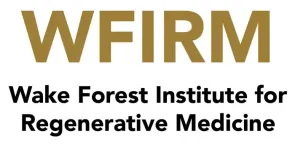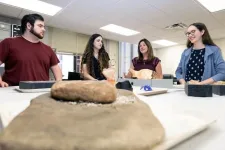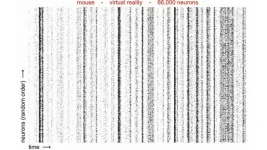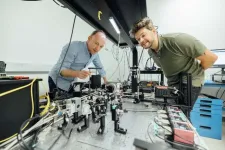(Press-News.org) The Wake Forest Institute for Regenerative Medicine (WFIRM) has been awarded an eight-year contract, valued up to $48 million from the U.S. Department of Health and Human Services (HHS) to support the utilization of cutting-edge body-on-a-chip technologies aimed at studying and developing potential treatments for sulfur mustard and other fibrosis-inducing chemicals. The program has been approved with an initial contracting commitment of approximately $18 million.
This contract represents a continued partnership between WFIRM and the Biomedical Advanced Research and Development Authority (BARDA), part of the HHS Administration for Strategic Preparedness and Response (ASPR). In 2019, WFIRM received a $30 million BARDA award to study the effects of chlorine gas exposure using body-on-a-chip technologies. That award allowed WFIRM to create realistic models of lung injury from chlorine gas, paving the way to identify potential medical countermeasures against chemical inhalation injuries.
Building on the success of this research, WFIRM will expand the technology to study fibrotic effects of toxic chemical agents on both the skin and airways.
Chemical exposures, including sulfur mustard, can cause debilitating and life threatening injuries. Used as a chemical warfare agent in World War I and more recently in the Iraq-Iran War (1980s) and Syrian Civil War (2013-2015) sulfur mustard causes blistering of the skin, damage to the eyes, and respiratory tract injury. Developing effective treatments for these injuries is vital to public health and national security.
The body-on-a-chip is a miniaturized system of human organs created using regenerative medicine techniques that models the body’s response to harmful agents, tests the effects of new compounds during drug discovery, and aids in the development of potential therapies. This system overcomes the substantial limitations of animal models and 2D cell culture models for studying mechanisms of disease. The response of these organ models to fibrosis-inducing chemicals like sulfur mustard will aid in the discovery and development of new medical countermeasures to guide future treatments.
"We are excited to continue our partnership with BARDA and further develop the body-on-a-chip models," said Dr. Anthony Atala, Principal Investigator and Director of the Wake Forest Institute for Regenerative Medicine. "The work we did with chlorine gas has been instrumental in advancing our understanding of chemical-induced injuries, and this new funding will allow us to apply these insights to develop critical medical countermeasures for chemical agents."
Testing new treatments using body-on-a-chip systems can reduce the cost, time, and risks associated with traditional early-stage pre-clinical studies.
“The ability to promote the development of medical countermeasures for chemical threats is crucial,” said Sean Murphy, co-lead for the project. “By accurately replicating human responses to toxic chemical exposure, WFIRM’s innovative technology could accelerate the pace of discovery and development of medical countermeasures.”
This project has been supported in whole or in part with federal funds from the Department of Health and Human Services; Administration for Strategic Preparedness and Response; Biomedical Advanced Research and Development Authority (BARDA), under contract number 75A50124C00044.
This award is part of BARDA’s Chemical, Biological, Radiological, and Nuclear (CBRN) Division’s portfolio of medical countermeasures. For more information on BARDA’s CBRN Division and its ongoing initiatives, please visit CBRN Portfolio.
About Wake Forest Institute for Regenerative Medicine
The Wake Forest Institute for Regenerative Medicine is recognized as an international leader in translating scientific discovery into clinical therapies, with many world firsts, including the development and implantation of the first engineered organ in a patient and the development of body-on-a-chip technologies using regenerative medicine strategies. Over 550 people at the institute, the largest in the world, work on more than 40 different tissues and organs. A number of the basic principles of tissue engineering and regenerative medicine were first developed at the institute. WFIRM researchers have successfully engineered replacement tissues and organs in all four categories – flat structures, tubular tissues, hollow organs and solid organs – and 17 different applications of cell/tissue therapy technologies, such as skin, urethras, cartilage, bladders, muscle, kidney, and vaginal organs, have been successfully used in human patients. The institute, which is part of Wake Forest University, is located in the Innovation Quarter in downtown Winston-Salem, NC, and is driven by the urgent needs of patients. The institute is making a global difference in regenerative medicine through collaborations with over 500 entities and institutions worldwide, through its government, academic and industry partnerships, its start-up entities, and through major initiatives in breakthrough technologies, such as tissue engineering, cell therapies, diagnostics, drug discovery, biomanufacturing, nanotechnology, gene editing and 3D printing. Learn more at WFIRM.org.
END
Wake Forest Institute for Regenerative Medicine (WFIRM) awarded up to $48 million to utilize body-on-a-chip technologies to study fibrosis-inducing chemical injuries
2024-10-24
ELSE PRESS RELEASES FROM THIS DATE:
Study offers ‘compelling evidence’ for continuous stroke care improvement
2024-10-24
Research Highlights:
A retrospective look at Get With The Guidelines® – Stroke registry data from 2003 to 2022 finds substantial and sustained improvements in acute stroke care among those in the quality improvement program.
Researchers found increased adherence to evidence-based stroke care translates to better clinical outcomes and, ultimately, more patients being discharged home or to a skilled nursing facility more quickly.
Overall, authors say the positive trends suggest concerted quality improvement initiatives can improve ...
Professor awarded NEH grant to advance anthropology research collections at Texas A&M
2024-10-24
Dr. Katie Custer Bojakowski, an instructional assistant professor in the Department of Anthropology at Texas A&M University and the director and curator of its Anthropology Research Collections (ARC), has been awarded a Preservation Assistance Grant from the National Endowment for the Humanities (NEH).
The NEH’s Preservation Assistance Grants program helps organizations protect their collections of historical and cultural items, making sure they remain available for students, scholars and the public. These grants help address risks to these collections, ...
New tool helps scientists spot patterns in mountains of data
2024-10-24
Neuroscientists have learned a lot – like which neurons and circuits are associated with different behaviors – by recording the activity of small sets of neurons.
But what happens when you record thousands of neurons at one time? Or when you want to figure out the role of neurons when there isn’t an obvious external catalyst or you’re not sure what you’re even looking for?
That’s where Rastermap comes in.
The new visualization tool developed by the Stringer and Pachitariu labs at HHMI's Janelia Research Campus helps ...
Glomerular filtration rate changes following UTI in children with vesicoureteral reflux
2024-10-24
About The Study: This cohort study uses data from the Children With Vesicoureteral Reflux trial to assess estimated glomerular filtration rate (eGFR) changes in participants with vs without recurrent urinary tract infections.
Corresponding Author: To contact the corresponding author, David S. Hains, MD, MBA, email dhains@iu.edu.
To access the embargoed study: Visit our For The Media website at this link https://media.jamanetwork.com/
(doi:10.1001/jamapediatrics.2024.4546)
Editor’s Note: Please see the article for additional information, including other authors, author contributions ...
Dandelion-shaped supernova and zombie star
2024-10-24
In 1181, a new star shone near the Cassiopeia constellation for six months before disappearing. This event, recorded as a “guest star” by Chinese and Japanese observers almost a millennium ago, has puzzled astronomers for centuries. It is one of a few supernovae to be documented before the invention of telescopes. In addition, it remained an “orphan” the longest, meaning that none of the celestial objects visible today could be assigned to it. Now known as the supernova SN 1181, its remnant has only been traced in 2021 to the nebula ...
Experts call for clear and concise regulation of exosome-based treatments
2024-10-24
Clinics that offer exosome therapies claim they have the ability to repair and regenerate tissues and treat inflammatory and other immune-related conditions in a noninvasive way. Now, a team of bioethicists and legal scholars from Japan is sounding the alarm on the urgent need for stronger regulations surrounding these unproven interventions. Their letter appears October 24 in the journal Stem Cell Reports.
“Administering these treatments to patients without scientific evidence or a clear ...
Zebrahub: New atlas tracks zebrafish development like never before
2024-10-24
When early cartographers undertook perilous expeditions to map unknown corners of the world with sextants, compasses, and hand-drawn diagrams, it’s unlikely they imagined that someday anyone with an internet connection would have access to a seamless view of the entire planet from the comfort of their own home. Today, pioneering scientists are working to create a similar experience for a much tinier, but no less important domain: developing embryos. The goal is to track and map the behavior of each and every cell working together to create an adult lifeform, and present that map in a clickable, ...
Unnoticeable electric currents could reduce skin infections
2024-10-24
Using a few zaps of electricity to the skin, researchers can stop bacterial infections without using any drugs. For the first time, researchers designed a skin patch that uses imperceptible electric currents to control microbes. The results appear October 24 in the Cell Press journal Device.
“This opens up exciting possibilities for drug-free treatments, especially for skin infections and wound healing, where antibiotic-resistant bacteria pose a serious challenge,” says University of Chicago’s Bozhi Tian, one of the paper’s ...
Expanded newborn screening using genome sequencing for early actionable conditions
2024-10-24
About The Study: These interim findings demonstrate the feasibility of targeted interpretation of a predefined set of genes from genome sequencing in a population of different racial and ethnic groups. DNA sequencing offers an additional method to improve screening for conditions already included in newborn screening and to add those that cannot be readily screened because there is no biomarker currently detectable in dried blood spots. Additional studies are required to understand if these findings are generalizable to populations of different racial and ethnic groups and ...
In pioneering study, gene technology outperforms standard newborn screening tests
2024-10-24
Early results from a study of newborn screening methods show that DNA analysis picks up many more preventable or treatable serious health conditions than standard newborn screening and is favored by most parents who are offered the option.
The study—called GUARDIAN—is one of the first large-scale studies in the world to use genome sequencing as a method for newborn screening and is the first to publish preliminary results.
“The results show us that genome sequencing can radically improve children’s medical care,” says Joshua Milner, professor of Pediatrics, director of Allergy/Immunology and Rheumatology ...





